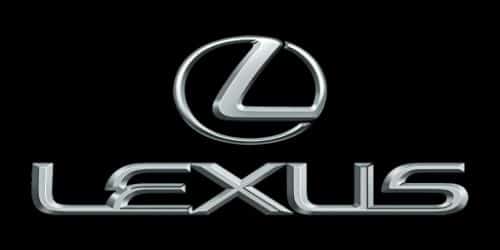Toyota owns the Japanese luxury automaker Lexus. The brand was established in 1983 and is one of the global leaders in the premium market sector, operating in more than 80 nations. Furthermore, this article will look at the Lexus logo history, evolution, color, font, etc.
History of the Company
The F1 project in the 1980s Eiji Toyoda, the chairman of Toyota, issued a challenge to create the best car in the world in 1983. Toyota started a top-secret project with the codename F1 (“Flagship One”) in response to this problem. The goal of the F1 project, whose result was the Lexus LS 400, was to create a flagship sedan that would increase Toyota’s product lineup, give it a footing in the premium market, and provide both existing and potential customers with a high-end product. The F1 project was launched in response to the sports car Toyota Supra and the high-end Toyota Cressida models’ popularity.
The Supra and Cressida had a potent 7M-GE/7M-GTE inline-six engine and were rear-wheel drive vehicles. The only V8-powered and largest sedan Toyota produced then was the limited-edition, 1960s-era Toyota Century, followed by the inline-six-powered Toyota Crown premium sedan. Despite undergoing a complete restyle in 1982, the Century was conservatively fashioned for the Japanese market and, along with the Crown, was not intended for export. International markets were the focus of the new sedan’s design, and work on a new V8 engine was started.
1980-1988
Due to voluntary export limits that the Japanese government and U.S. trade negotiators had agreed to in the 1980s, which limited sales of mainstream cars, Japanese manufacturers had more opportunities to export more expensive models. Toyota’s plans for a luxury division were influenced by Honda’s launch of the Acura brand in the United States in 1986.
The first Acura model was an export version of the Honda Legend, which was introduced in Japan in 1985 as a competitor to the Toyota Crown, Nissan Cedric/Gloria, and Mazda Luce. Nissan announced its intentions to develop the luxury brand Infiniti in 1987.
To prepare their prestigious Nissan President sedan for export as the Infiniti Q45, which it did in 1990, Nissan updated it to standard wheelbase form. Mazda started selling the Luce as the Mazda 929 in North America in 1988. Later, the company began planning to create the upmarket Amati nameplate, but those plans were never realized.
In May 1985, Toyota researchers traveled to the USA to conduct focus groups and market research on high-end buyers. Several F1 designers rented a house in Laguna Beach, California, during that time to observe the habits and preferences of American upper-class buyers. While this happened, F1 technical teams tested prototypes on everything from American roads to the German autobahn. After doing market research, Toyota concluded that a distinct brand and sales channel were required to introduce its new flagship sedan, and preparations were undertaken to create a new dealership network in the U.S. market.
Brand Building
To manage the marketing for the new premium brand, Team One, a specialized division of Toyota’s venerable advertising firm Saatchi & Saatchi, was established in 1986. Vectre, Verone, Chaparral, Calibre, and Alexis were selected as the top contenders after 219 potential names were compiled by the image consulting firm Lippincott & Margulies. While Alexis quickly rose to the top, there were objections that the name applied more to people than cars (being linked to the Alexis Carrington character on the well-liked 1980s primetime drama Dynasty), so the first letter was dropped. Then I was changed to a “u” to change the name to Lexus.
The phrases “luxury” and “elegance” have been suggested as the origin of the name Lexus, but another hypothesis suggests that it is an abbreviation for “luxury exports to the U.S.” The brand name has no particular meaning, and it just connotes an opulent and technological image, according to Team One interviews.
Read Also: MAZDA LOGO: The Story Behind Mazda
The database company LexisNexis secured a temporary injunction prohibiting the use of the name Lexus just before the debut of the first cars, claiming that it would lead to misunderstanding. The division’s debut and marketing initiatives ran the risk of being delayed by the injunction. After some thought, a U.S. appeals court lifted the order, concluding that there was little chance that the two goods would confuse.
The Relentless Pursuit of Perfection” was the original Lexus tagline, created when Team One representatives visited Lexus designers in Japan and observed their meticulous attention to detail. Hunter Communications and Molly Designs created the Lexus logo. According to Toyota, the final Lexus logo was created using a precise mathematical technique and featured a stylized “L” inside an oval. The 1988 Chicago, Los Angeles, and New York car show Team One’s first teaser advertisements with the Lexus name and emblem debuted.
Launch
The F1 project was finished in 1989 following a protracted development process requiring 60 designers, 24 engineering teams, 1,400 engineers, 2,300 technicians, 220 support staff, roughly 450 prototypes, and a cost of over US$1 billion.
The resulting flagship, the Lexus LS 400, had a brand-new 4.0 L V8 gasoline engine, rear-wheel drive, and a distinctive style with no significant design cues from earlier Toyota vehicles. The LS 400 made its world debut at the North American International Auto In In In January 1989; it was formally introduced for sale at 81 new Lexus dealerships across the country in September of that same year. The ES 250, based on the Toyota Camry, was sold alongside the LS 400. The launch of Lexus was announced by print and TV ads that cost millions of dollars.
When it first came out, the LS 400 was praised for being quiet, having a well-designed interior, having a good engine, being well-built, being aerodynamic, getting good gas mileage, and being a good value. On the other hand, some auto columnists didn’t like it because it looked like a lot of different cars and had a suspension that, in their opinion, made it less fun to drive.
Read Also: MUSTANG LOGO: The History of The Mustang Logo
The LS 400 was rated by Car and Driver magazine as having superior ride, handling, and performance to the US$63,000 Mercedes-Benz 420 SEL and the US$55,000 BMW 735i. It made its debut in the US at $38,000 (in some markets, it was priced against mid-size six-cylinder Mercedes-Benz and BMW models). Major driving honors for the LS 400 came from publications like Automobile Magazine and Wheels Magazine.
Even though Lexus was a new brand, it quickly won over customers, and its arrival was seen as a big shock to the other luxury brands. BMW officials accused Lexus of dumping in that market, and Mercedes-Benz and BMW’s U.S. sales figures fell by 29% and 19%, respectively. 35% of people who bought a Lexus paid for it by trading in a Lincoln or Cadillac.
1989
Lexus started a voluntary recall of all 8,000 LS 400s in December 1989 due to two customer complaints about faulty wiring and overheated brake light. During a massive 20-day operation that replaced the parts on all impacted vehicles, Lexus sent experts to pick up, fix, and return automobiles to clients free of charge. Also, people were flown in, and garage space was reserved for owners who lived faraway places. The press praised this approach and helped the brand get a good reputation early on for good customer service.
16,392 LS 400 and ES 250 sedans had been sold by the end of 1989, four months after their U.S. introduction. Sales started slower than anticipated, but they met the division’s goal of 16,000 units for the year. Plans called for reworking the ES sedan and adding a sports coupe after the initial generations.
The 1990s: Development and Growth
In 1990, Lexus sold 63,594 LS 400 and ES 250 sedans in the United States during its first full year of business, with the LS model accounting for the great majority. Limited exports of Lexus vehicles to the UK, Switzerland, Canada, and Australia also started that year. The SC 400, a sports coupe that shared the LS 400’s V8 engine and rear-wheel drive system, was introduced by Lexus in 1991. The second-generation ES 300 sedan, which succeeded the ES 250 and became Lexus’ best-selling model, came next. With 71,206 vehicles sold by the end of 1991, Lexus had overtaken BMW as the most popular premium import in the country.
Lexus came out on top in J.D. Power and Associates assessments on the quality of new vehicles, customer satisfaction, and sales satisfaction for the first time. In 1992, the introductory price of the LS 400 had increased 18% to close to US$45,000, surpassing comparable American premium manufacturing costs but remaining below high-end European models. The brand also started raising prices for U.S. models.
Based on the Toyota Aristo and the Toyota Crown, which had been on sale in Japan for two years prior, Lexus introduced the mid-size GS 300 sports sedan in 1993. In the portfolio of the marque, the GS 300 was more affordable than the LS 400. Lexus was one of the first car companies to start a certified pre-owned program in the same year. This was done to boost the value of trade-in models. The company’s best car, the LS 400, got a complete makeover for the second generation, which came out in 1994. Sales were endangered in May 1995 when the U.S. government proposed 100% taxes.
Read Also: MUSTANG LOGO: The History of The Mustang Logo
In response to the expanding U.S.-Japan trade deficit, upmarket Japanese automobiles SUVs were not subject to the suggested penalties. When the Japanese automakers agreed to put more money into the U.S. and the tariffs were dropped at the end of 1995, sales returned to normal.
The third generation ES 300 sedan and the first sport utility vehicle from Lexus, the LX 450, both made their debuts in 1996. During the U.S.-Japan trade talks in 1995, the brand’s plans to make an SUV model moved forward. In 1998, Lexus released the second-generation GS 300 and GS 400 sedans and the RX 300, the first luxury brand crossover SUV.
The RX crossover was trendy and sold more than the ES 300, making it the brand’s best-selling car. It was made for people in the suburbs who wanted a nice SUV but didn’t need the off-road capabilities of the LX. In the same year, Lexus began selling vehicles in Brazil, the most populous nation in South America. As the top-selling premium car manufacturer in the United States in 1999, Lexus sold its millionth car in the American market.
Global Rearrangement in the 2000s
The IS line, a new series of entry-level sports sedans, was introduced by Lexus in 2000. The third generation LS 430, a revamped ES 300, and the brand’s first convertible, the SC 430, debuted in 2001. In 2002, the GX 470 mid-size SUV made its debut, while the second-generation RX 330 followed in 2003. The next year, Lexus sold two million vehicles in the United States, and the RX 400h, the company’s first production hybrid SUV, made its debut.
Unlike cars that only ran on gasoline, this one had a Lexus Hybrid Drive system that combined electric and gasoline motors for more power, better gas mileage, and less pollution.
With the specialized design, engineering, training, and manufacturing departments working only for the division, Lexus successfully established organizational independence from the parent firm at Toyota in 2005. At the same time as this initiative, Lexus was introduced in its home country of Japan and other important countries worldwide, such as China. Executives wanted to grow Lexus sales outside the U.S., the brand’s biggest market.
Next-generation Lexus vehicles were redesigned as “global models” for international release to go along with this expansion. The Lexus brand recently announced plans to add hybrid and diesel powertrains, increase the number of Lexus dealerships, and expand operations in emerging markets like Russia. For a long time, the company had trouble selling cars in Europe because the brand wasn’t well known, there weren’t enough dedicated dealerships, and import quotas from the 1990s made it hard to bring in new customers.
Read Also: Toyota financial: Toyota reviews 2023( + Top Toyota services app, login, Address, and Payoff number)
The first Japanese premium automobile brand to enter the domestic market was Lexus, which debuted in Japan in July 2005. After the SC 430 and the new generation LS, IS, ES, GS, and RX models were made available in Japan, the domestic sales of Toyota-branded cars with the nameplates Celsior, Altezza, Windom, Aristo, Harrier, and Soarer, respectively, came to an end.
The Windom, Celsior, Harrier, and Soarer were previously available at Toyota Store and Toyopet Store locations. However, the Altezza and Aristo were once only sold through the Japanese Toyota retail sales channels known as Toyota Vista Store. When you compare Toyota cars that are no longer made to Lexus cars sold in Japan, you can see that Lexus cars have more features and cost more (from 1 million yen and up). Sales were slower than expected in the first half of the year because the domestic auto market was in a recession, and prices were rising. However, sales picked up in the year’s second half because more cars were available.
The brand also did well in the Middle East, where it ranked first or second among competitors in several countries, and in Australia, where Lexus reached third place in luxury car sales in 2006. Throughout the middle of the 2000s, Lexus experienced sales successes in South Korea and Taiwan, becoming the top-selling import in both markets in 2005. In 2006, division executives declared a plan to grow from 68 to 76 countries globally by 2010. By the end of the decade, this expansion led to the formal launches of the Philippines in 2009 and Malaysia in 2006, as well as South Africa and Chile.
F Models and Hybrids
In addition to launching the fourth generation of its flagship LS line, which includes both normal and long-wheelbase V8 (LS 460 and LS 460 L) and hybrid (LS 600h and LS 600h L) models, Lexus started selling the GS 450h, a V6 hybrid sports sedan, in 2006. In the same year, the ES 350 of the fifth generation made its debut. With a sticker price of over $125,000, the LS 600h L went on sale as the most expensive sedan ever created in Japan. By the end of 2006, Lexus had sold 475,000 vehicles annually worldwide.
A new F-brand performance branch, which would create versions of its performance cars with a racing aesthetic, was introduced by Lexus in January 2007. The first model in this line, the IS F, made its debut at the North American International Auto Show in 2007, along with a supercar concept car called the LF-A.
Although previous Lexus models, such as the SC 400 and GS 400, received positive feedback from sport luxury buyers, other Lexus vehicles were criticized for prioritizing comfort over sporty road feel and handling compared to European competitors. By the end of 2007, Lexus’ yearly global sales had topped 500,000 units, and for the first time, the brand was China’s best-selling premium import. In terms of size, the largest sales markets in 2007 were the United States, Japan, the United Kingdom, China, Canada, and Russia.
2008
Due to the recession in the late 2000s and a weakening global auto market, global sales dropped by 16% in 2008 to 435,000 units. This included 21% and 27.5% drops in the U.S. and Europe, respectively. Later that same year, the brand released the US$375,000 LFA exotic coupe, the HS 250h hybrid sedan for North America and Japan, the RX 450h hybrid SUV, and the RX 400h. In late 2009, Lexus declared plans to become a hybrid-only marque in Europe, claiming more robust hybrid car sales than its petrol-powered rivals. After the decade, Lexus was the top-selling premium car brand in the United States for ten years and was the fourth-largest premium car manufacturer globally by volume.
2010s: Current Events
Lexus sales in North America and Asia went up slowly but steadily in 2010 as the company focused on making hybrid cars and new versions of its models. Despite Toyota vehicle recalls in 2009 and 2010, some of which involved Lexus vehicles, sales in the United States remained stable. A recall for possibly jammed floor mats affected the ES 350 and some IS models.
Toyota’s parent corporation took the brunt of the criticism in the wake of inquiries into its product recalls and problem rates per vehicle. In April 2010, the revised GX 460 was voluntarily recalled for a software update. This happened a week after Consumer Reports told people not to buy the SUV because it could roll over if the stability control didn’t respond well to a high-speed emergency turn. Even though there had been no accidents with the GX 460, the software for its stability control was changed.
The Lexus CT 200h, a small, four-door hybrid hatchback built for Europe, went on sale in several regions in late 2010 and early 2011. Sales of regional models with less displacement have also increased, starting with the ES 240 in China and then the RX 270; other markets that have gotten model variants with lower emissions or import tariffs include Japan, Russia, and Taiwan. In March 2011, the Thoku earthquake and tsunami messed up Lexus’s production lines in Japan, which hurt the brand’s short-term sales.
Read Also: MERCEDES BENZ: The Untold Story of the World’s No. 1 Car Brand
According to Lexus’ U.S. officials, the company won’t continue to be the top-selling premium automobile brand in the nation because of product shortages and intense rivalry from BMW, Mercedes-Benz, and Audi. A total of 410,000 units were sold globally in 2011, with a 14% decline in sales in the U.S. market and rises of 40% and 27%, respectively, in Europe and Japan. That year, BMW overtook Lexus as the best-selling luxury brand in the United States after a run of eleven years, with Mercedes-Benz coming in second.
While the RX premium crossover SUV accounted for 45 percent of Lexus sales in the US in 2011, Mercedes-Benz’s best-selling model was the E-Class mid-luxury sedan, which fetches far higher prices. Recognizing that “back then, we didn’t treat Lexus as a brand, but as a distribution channel,” Toyota chairman Akio Toyoda then committed to reviving the marque’s passion and expanding its organizational independence. Toyoda’s organizational changes have led to senior management at Lexus reporting directly to the chairman for the first time in the brand’s history.
The brand started selling the fourth generation GS line, which includes the GS 350 and GS 450h variations, as well as a smaller-displacement GS 250 model, in January 2012.
The sixth generation ES line, which includes the ES 350 and ES 300h models, made its debut at the New York International Auto Show in April 2012.
History Of the Lexus Logo
The Lexus logo was made in the summer of 1987 and showed up for the first time in 1988. It is easily identifiable. The Lexus logo, a stylized “L” ringed by an oval with a steel gray finish, is drenched in simplicity and perfection. The color represents originality, excellence, class, and modernity. It’s interesting to note that the font for the brand’s full name doesn’t change due to the shape of the “L.”
The company insisted that the logo’s curves be round and egg-shaped to show “the aerodynamic quality of Lexus vehicles.” Some say the logo’s shape is also based on an exact mathematical formula. Hunter Communications and Molly Designs collaborated on its design.
Lexus’s name surprises people; its history is somewhat uninteresting.
Design of the Lexus Logo
The designers wanted to produce a solid and distinctive bespoke typeface. And they were very successful. The colorful typeface and overall design work flawlessly to give the brand a sophisticated and cutting-edge appearance.
Its original design has undergone some modifications. In 1986, Molly Designs and Hunter Communications received a commission to design a badge. Two years later, the first advertisements debuted at one of the largest US auto shows. Since then, the Lexus logo has become one of the most recognizable symbols in the automotive industry.
The Lexus logo is a steel gray color and shows creativity and style because it is so simple. If you look attentively, you will notice that the Lexus insignia has a tremendously smooth addition and is somewhat curved.
If you look at the Lexus logo’s shape, you could assume it’s a straightforward design, but remember that two teams collaborated to make it. The stylized L and the surrounding oval make up the Lexus logo. The oval form complements the primary Toyota logo.
Because many people seem to think specific components resemble the Subaru logo, it is comparable to that mark.
How was the name Lexus Chosen?
Toyota’s advertising division, Team One, asked the New York-based brand consultancy, Lippincott & Margulies, to come up with a suitable name for their new luxury brand in 1986.
You might be shocked that the group had several names before “Lexus.” Lexus wasn’t even on Lippincott & Margulies’ list of 219 potential names for Toyota. At the time, the front-runner was “Alexis,” which later became “Lexis,” and then “Lexus.” Verone, Chaparel, Vectre, and Calibre were competitors that were defeated by this title.
The Lexus name is still interpreted in two ways: either it stands for “luxury exports to the US,” or it combines the words “luxury” and “elegance.” Team One asserts that the moniker has never had any particular significance.
Nevertheless, the Lexus website asserts that it is a compound of root words. These include the Greek “lexicon” for language and terms, as well as the Latin and French words “Luxus” and “luxe” for elegance and opulence. The website says that the result is a new, unique word that means “luxury” in all languages.
The Lexus Logo’s Font
This automotive company focused on its font and did a fantastic job with it. The Lexus typeface is intricate and employs silver to resemble the symbol. It also makes excellent use of negative space.
If you look attentively, an arrow forms between the left side of the X and the three arms of the E. It’s meant to show how fast you can go in a Lexus. It is a fantastic reminder that the business makes high-quality luxury sports cars.
The Lexus Logo is in what font? Symbol for Lexus
The font used for the Lexus logo was specially designed for the company. The sans-serif all-capital letter typeface used for the Lexus wordmark was explicitly created for the company by its design team.
The business says that the “E” and the almost-connected “X” are styled to look like an arrow pointing toward the future.
The Lexus wordmark’s letters are incredibly near to one another and almost appear joined, which helps to establish a stylish flow. The brand image is balanced and at ease, thanks to diverse curves.
Although it has a similar weight, the “L” inside the Lexus oval is written in a very different font from the remainder of the wordmark. In this case, the ” L ” removes sharp angles and replaces them with a softer, smoother curve.
Lexus Logo’s Color Scheme
The Lexus logo is primarily displayed in silver on the vehicles they produce. On other media platforms, the Lexus logo never shows up in different colors or is changed in any way. It is always done in black or white. Last but not least, if we look at the brand book, Lexus’s typography and logo will be the same color.
Definition of the Symbol
The brand’s logo is an “L” with a dynamic curve and an oval. Together, they stand for luxury that doesn’t need to be shown.
Colors of the Lexus Logo
The hue of the Lexus logo has mostly remained the same over time, as was already established. Steel grey was the original selection for the former Lexus logo’s hue. You’ll still see variations of the new Lexus logo in this color.
But if gradients are used in some places, the symbol might look slightly metallic.
The hue of the Lexus logo may occasionally change to black and white. Even though the chrome option is available in many brand assets, the monochrome logo is most often used in marketing brochures and press releases.
Silver typically represents modernity and innovation, whereas grey typically represents refinement. Typically, the colors black and white stand for strength and sophistication.
Describe the Lexus Logo
A solid and beautiful bespoke typeface is used in the Lexus symbol. The beautiful typeface fits the situation wonderfully.
Currently, the company has several models, one of which is an off-road vehicle.
The two most significant innovations introduced by Lexus at the Geneva motor show in 2016 reveal the company’s future aspirations. The Japanese have chosen to concentrate their efforts on promising technologies.
The well-known reliability is no longer good enough, and the Japanese have taken a strong interest in changing the brand’s image. It is displayed in the sports coupe Lexus LC 500 with the five-liter V8 engine at the Geneva Salon.
However, the Lexus LC’s designer frills—however eye-catching they may be—are not the only features that ought to live on in the minds of future generations. The vehicle is built on the brand-new GA-L rear-wheel-drive platform, which will later start to appear in other vehicles. The coupe also introduces a brand-new hybrid multi-stage technology. The Japanese engineers improved the powertrain’s efficiency by adding a four-step automatic transmission, making it more effective than similar plants built using the earlier technology.
The engineers at Lexus are optimistic that a luxury car running on hydrogen fuel will enter production four years from now, in 2020. The Lexus LF-FC concept is the first product of the technology’s adaption to meet the needs of wealthy Lexus customers. In LF-FC, the driver may operate the onboard computer, multimedia, and navigation using a holographic menu that responds to hand motion. The same kind of future that Hollywood filmmakers imagined thirty years ago exists now. And there it is.
How popular is the Lexus logo is
The Lexus logo is hip and contemporary and has a unique history. They did a terrific job when they developed it since it is a straightforward symbol that complements the strength and flair of the vehicles they produce.
We must genuinely appreciate how it seems, and there is a reasonable probability that it will continue to look that way.
In conclusion, the Lexus logo is a well-known one that never ceases to amaze us with its simplicity and elegance while coming from a brand that was just recently introduced in the automotive market.
Alterations and Evolution
In the years after the brand launched in Western markets in 1989, its logo underwent little alterations. The backdrop oval was the only one to occur.
However, these kinds of minor design adjustments can’t truly be regarded as legitimate logo changes, and something more significant would have been required to note it.
How Did the Lexus Name Get Started?
Because Toyota decided to make a luxury automobile in 1983, Lexus might be seen as a young business. Toyota had to make a move after Nissan and Honda debuted their premium Infiniti brands and their respective luxury Acura marques.
So, they made this high-end brand, and the LS400 sedan was its first model. In 1090, Lexus used this model to launch its operations in the US and Canada. The Lexus emblem today demonstrates the excellent work that this luxury brand has done and its high market value.
Conclusion
Compared to many other automobile logos now on the market, the Lexus logo is significantly less complicated. This symbol doesn’t have a lot of hidden significance, but it nevertheless has a big impression on everyone who sees it.
The Lexus logo still fulfills its function as a mark of luxury today.
The Lexus logo is sleek and simple, with smooth curves that are meant to make you think of the cars themselves. It uses a similar design philosophy to the more prominent Toyota logo.
Because of the logo’s efficacy, the business didn’t need to adjust its appearance much over time.
If you want to understand more about the iconic emblems behind well-known businesses, don’t forget to read our other entries about vehicle logos.
Related Articles
- CONSUMER CREDIT: Meaning, Types, Pros, and Cons
- Toyota financial: Toyota reviews 2023( + Top Toyota services app, login, Address, and Payoff number)
- SECRET FACTS ABOUT TOP BRANDS 2023
- ERP SYSTEMS: Top Best Options in 2023 (Updated!!)
- BEST CAR BRANDS for Reliability in 2023 (Top Picks & All You Need)






